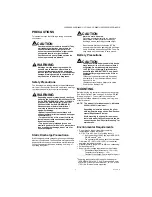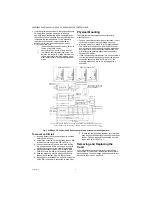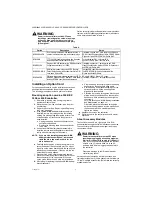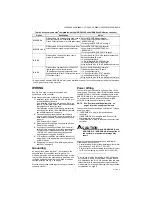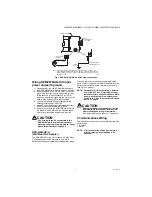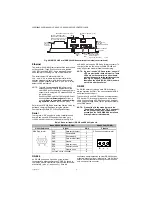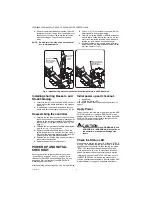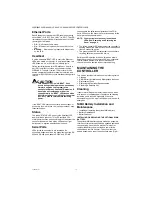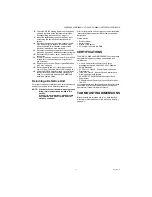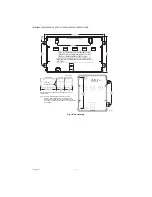
WEB-300E, WEB-600E/U, CP-300E, CP-600E/U SERIES CONTROLLERS
13
31-00010—01
ABOUT BACKUP
CONFIGURATIONS
A 300E or 600E series controller allows two separate and
configurable methods to preserve unsaved station data
when "power quality events" occur, including loss of
primary power or low-voltage dips (brownout):
• Using the integral static RAM (SRAM) on the
controller’s NPM3E or NPM6E processor module. This
default method can allow the unit to operate “battery-
less”, that is, without installing the optional NiMH
battery pack. Note in this configuration a controller
reboot is likely to occur whenever a power outage or
voltage dip is sustained for more than one AC line
cycle (1/50th or 1/60th of a second) or a number of line
cycles, depending on the load and power supply.
Critical station data will already be saved prior to any
power quality event, but the NiMH battery option is
available to prevent nuisance controller reboots/station
restarts during extended or frequent power outages.
• An optional on-board NiMH battery pack. Installing this
battery allows the controller to continue operation
(without rebooting) over short power outages or
brownouts lasting several seconds (or if also using
SRAM, up to 10 minutes). For longer duration outages,
the battery allows the controller to perform a
“controlled shutdown”, safely backing up the station
before shutting down.
Starting in the WEBs-AX 3.6.47 maintenance build, the
controller can use both the NiMH backup battery and
available SRAM for backup protection (prior to this, SRAM
support required removing backup batteries). Configuring
for both backup battery and SRAM support provides the
most comprehensive backup protection. This allows the
controller to “ride out” brief power outages, while also
protecting against a scenario of a battery too weak (or
aged) to perform a controlled shutdown.
SRAM
The controller’s NPM3E or NPM6E processor module
includes on-board SRAM and associated circuitry,
allowing “battery-less” operation. This is the same
circuitry as provided by the “SRAM option card” for earlier
QNX-based controller models, available since the initial
release of WEBs-AX 3.6.47. Therefore, an SRAM option
card is not needed (or supported) in a 300E or 600E
series controller.
The default configuration is to use SRAM for station
backup, via the platform “DataRecoveryService” that is
automatically created in the controller’s running station.
However, in some cases, a station may be a poor
candidate for SRAM support, requiring too many
resources by this associated platform service. An
example is a station with many rapidly changing values all
captured as histories, on COV. In this case, you may wish
to disable SRAM support, and install and use only the
optional NiMH battery pack.
For an overview, see “About Backup Configurations” on
page 13. Complete WEBs-AX details on the operation of
the controller’s integral SRAM are in the JACE Data
Recovery Service (SRAM support) - Engineering Notes
document.
NiMH battery pack
A custom 10-cell NiMH (nickel metal hydride) battery
assembly is available as a
separately orderable option
for
a 300E or 600E series controller. This battery assembly
incudes a metal bracket with the tie-wrapped NiMH
battery pack. It is the same battery assembly installed in
the previous 201 and 600 series controllers.
This battery allows the controller to continue station
operation through short power bumps, ranging from a few
seconds to a minute or more in duration (up to 10
minutes, if also using SRAM). If a longer outage, the
NiMH battery provides enough run time for the unit to
backup data and then shutdown. Shutdown occurs
automatically, after data is backed up to on-board flash
memory.
The controller charges the battery during normal
operation, until fully charged. Typically, the charge
operation completes within 18 hours. Following a power
outage, the battery is charged again, as necessary. The
power and battery circuitry is monitored by a station
running on the JACE (via its PowerMonitorService).
Station alarms are generated whenever primary power is
lost, or if the battery is uncharged or unable to hold a
sufficient charge.
NOTE: A NiMH battery characteristic is to lose
charge if not left in charge mode (trickle
charge). Leaving the battery unconnected, or
in the unit powered off will cause the battery
to fully discharge in a matter of weeks. Note
that a new NiMH battery may be partially dis-
charged. Therefore, allow at least 18 hours
for a new battery to charge if it has not been
in a powered unit.
The NiMH battery assembly should be replaced
approximately every three years, or more often if the unit
is in a high temperature environment. For more details,
see “NiMH Battery Installation and Maintenance” on
LED STATUS INDICATORS
The controller includes several LEDs that can help
determine the status of the unit. They are located in two
places: the top of the controller, visible through the cover,
and for serial ports, on the bottom board (only with cover
removed).
From left-to-right these LEDs include:
Visible on cover:
• Ethernet Ports
• Heartbeat
• Status
Bottom board only:
• Serial Ports
LED Status Indicators.
COM 2
SERIAL PORT LEDS ON BOTTOM
BOARD, REMOVE COVER TO SEE: LAN2
(SEC)
LAN1
(PRI)
BEAT
STATUS
STATUS LEDS (VISIBLE WITH COVER ON):
COM 1
M34997



